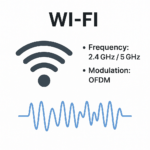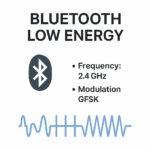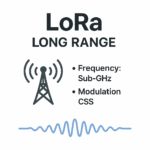When I started building IoT devices, the wireless part always tripped me up. Wi-Fi felt like the obvious go-to, but then I’d see tutorials using Bluetooth or LoRa instead—and suddenly I wasn’t so sure.
If you’re in that spot, this guide is for you. I’ll break down how Wi-Fi, Bluetooth (especially BLE), and LoRa work, what radios and frequencies they use, and how to decide which one fits your project best.
Wi-Fi in IoT: High-Speed Connectivity for Data-Intensive Applications

Wi-Fi is a ubiquitous wireless technology that operates primarily in the 2.4 GHz and 5 GHz frequency bands. It employs Orthogonal Frequency Division Multiplexing (OFDM) modulation, enabling high data throughput suitable for bandwidth-intensive tasks.
Read a very interesting book about Hidden Universe of Radio Waves
Technical Specifications:
- Frequency Bands: 2.4 GHz and 5 GHz
- Modulation: OFDM (802.11 standards)
- Typical Range: Up to 100 meters indoors
- Data Rates: Up to 150 Mbps with ESP32 modules
- Power Consumption: Approximately 200–300 mA during transmission
- Transmit Power: Up to +20 dBm (100 mW)
Ideal Use Cases:
- Streaming video from devices like the ESP32-CAM
- Real-time data dashboards
- Smart home devices requiring constant internet connectivity
Advantages:
- High data transfer rates
- Direct internet access
- Wide availability of infrastructure
Limitations:
- Higher power consumption
- Limited range, especially through obstacles
- Potential interference in crowded frequency bands
For a practical implementation, consider exploring our project on ESP32-CAM edge detection, which utilizes Wi-Fi for transmitting video data.
Bluetooth Low Energy (BLE): Efficient Connectivity for Low-Power IoT Devices

Bluetooth Low Energy (BLE) is a wireless communication protocol designed for short-range data exchange with minimal power consumption. Operating in the 2.4 GHz ISM band, BLE utilizes Gaussian Frequency Shift Keying (GFSK) modulation across 40 channels, each 2 MHz wide. This configuration allows BLE devices to maintain efficient communication while preserving battery life.
Technical Specifications:
- Frequency Band: 2.4 GHz ISM
- Modulation: GFSK
- Channels: 40 (2 MHz each)
- Typical Range: 10–50 meters (extendable with Bluetooth 5 features)
- Data Rates: 125 Kbps to 2 Mbps
- Power Consumption: As low as 0.01 mA in sleep mode; ~10–15 mA during transmission
- Transmit Power: Typically up to +10 dBm (10 mW)
Ideal Use Cases:
- Wearable fitness trackers
- Smart home sensors
- Proximity beacons
- Battery-powered medical devices
Advantages:
- Ultra-low power consumption, enabling extended battery life
- Native support in most modern smartphones and tablets
- Suitable for applications requiring infrequent data transmission
Limitations:
- Limited range compared to other wireless technologies
- Lower data throughput, not ideal for high-bandwidth applications
- Requires a gateway or smartphone for internet connectivity
For a practical implementation, consider exploring our project on BLE-based automatic barrier opener, which utilizes BLE for secure and efficient access control.
LoRa: Long-Range, Low-Power Communication for Remote IoT Deployments

LoRa (Long Range) is a wireless communication technology designed for long-distance, low-power applications.
Operating in sub-GHz frequency bands, LoRa utilizes Chirp Spread Spectrum (CSS) modulation to achieve extended range and robustness against interference.
Technical Specifications:
- Frequency Bands: 868 MHz (Europe), 915 MHz (North America), 433 MHz (Asia)
- Modulation: Chirp Spread Spectrum (CSS)
- Typical Range: 2–15 km in rural areas; up to 40 km under ideal conditions
- Data Rates: 0.3 to 50 kbps
- Power Consumption: Approximately 10–30 mA during transmission; microampere levels in sleep mode
- Transmit Power: Up to +20 dBm (100 mW)
Ideal Use Cases:
- Environmental monitoring (e.g., air quality, water levels)
- Agricultural applications (e.g., soil moisture sensors)
- Asset tracking in logistics and supply chains
- Smart city infrastructure (e.g., street lighting, waste management)
Advantages:
- Extensive range suitable for rural and urban deployments
- Low power consumption enabling multi-year battery life
- Operates in unlicensed frequency bands, reducing operational costs
Limitations:
- Low data throughput, not suitable for high-bandwidth applications
- Requires a LoRaWAN gateway for internet connectivity
- Potential for network congestion in densely populated deployments
For more detailed technical information, refer to the LoRaWAN Specification v1.1 provided by the LoRa Alliance.
Wi-Fi vs BLE vs LoRa: Side-by-Side Comparison
When choosing a wireless communication method for your IoT project, it helps to see the numbers and trade-offs clearly. Here’s a quick comparison of Wi-Fi, BLE, and LoRa across key technical and practical dimensions:
| Feature | Wi-Fi (ESP32) | Bluetooth Low Energy | LoRa (SX127x/RA-02) |
|---|---|---|---|
| Frequency Band | 2.4 GHz / 5 GHz | 2.4 GHz | 868 MHz (EU) / 915 MHz (US) |
| Modulation | OFDM (802.11 b/g/n) | GFSK | Chirp Spread Spectrum (CSS) |
| Range | ~50–100 m (indoor LOS) | ~10–50 m (can reach 100 m) | 2–15 km (rural LOS) |
| Data Rate | Up to 150 Mbps (ESP32) | 125 Kbps – 2 Mbps | 0.3 – 50 Kbps |
| Power Usage | High (200–300 mA TX) | Very Low (0.01–15 mA active) | Low (~10–30 mA TX) |
| Transmit Power | Up to +20 dBm | Typically +0 to +10 dBm | Up to +20 dBm |
| Battery-Friendly | ❌ | ✅ | ✅ |
| Internet Access | Direct | Via smartphone or gateway | Via gateway |
| Best For | Cameras, dashboards | Wearables, tags, sensors | Remote sensors, agriculture |
Related Articles You Might Like:
How to Choose the Right Wireless Tech for Your IoT Project
Choosing between Wi-Fi, BLE, and LoRa doesn’t have to be complicated. The best option depends on three core factors: how far you need to communicate, how much data you’re sending, and how power-constrained your device is.
Here’s a simple breakdown to guide your decision:
Choose Wi-Fi if:
- Your device is plugged into a wall or has regular access to power
- You need to stream data (like camera feeds or sensor dashboards)
- You want built-in internet access without extra gateways
Great for:
Smart home hubs, ESP32-CAM surveillance, data dashboards.
Choose Bluetooth (BLE) if:
- Your device runs on battery and needs to last a long time
- You only need to send small bursts of data
- You want to connect directly to smartphones or tablets
Great for:
Wearables, BLE beacons, proximity-based controls, low-power sensors.
Explore 10+ Bluetooth and BLE projects for ESP32
Choose LoRa if:
- Your devices are placed far away (up to 15 km line of sight)
- You only need to send tiny amounts of data occasionally
- You’re building something that must work off-grid for months or even years
Great for:
Agricultural sensors, weather stations, remote asset tracking.
Final Thoughts
There’s no one-size-fits-all in wireless IoT—each technology brings strengths to different scenarios. Start by asking yourself:
- How often does the device send data?
- How far apart are your devices and gateways?
- Is this device battery-powered or plugged in?
And remember: sometimes the best solution is a hybrid. For example, a LoRa sensor node can send data to a local ESP32-based Wi-Fi gateway, which uploads it to the cloud. Or a BLE sensor can trigger an ESP32 over Bluetooth and log data to a web server.
Whatever you build, test it in your real-world environment—and don’t be afraid to tinker.


1 thought on “Wi-Fi vs Bluetooth vs LoRa: Which Wireless Tech is Best for Your IoT Project?”